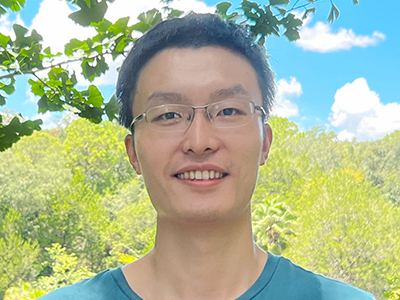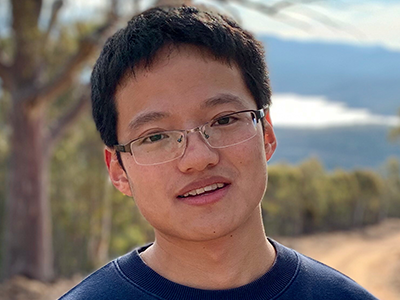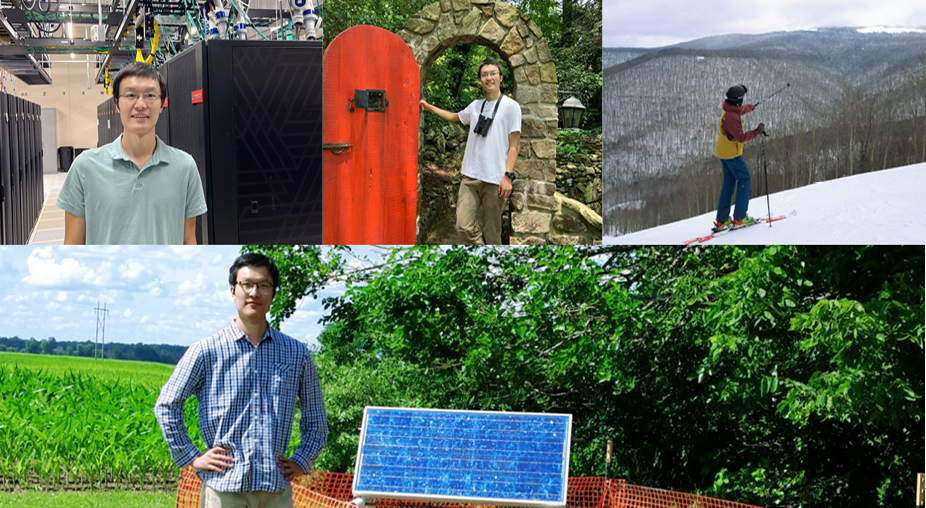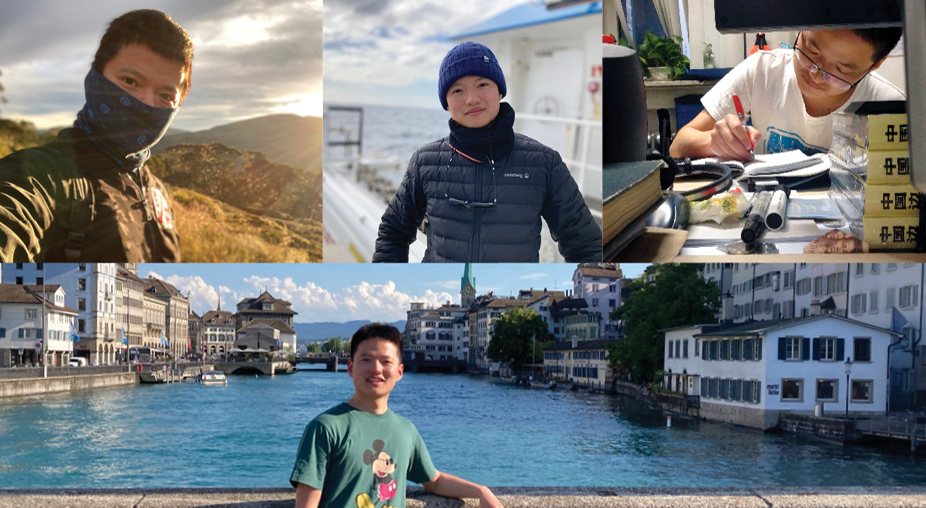Study of the Earth’s Deep Interior Awardees
Section Award for Graduate Research

Citation
Shangxin Liu’s research has shed new light on the role of subducted slabs and shallow, slow–wave speed anomalies in the dynamics of the North American plate. In his 2022 Geochemistry, Geophysics, Geosystems paper, Shangxin showed that large-scale mantle flow induced by subducting slabs in the western Pacific contributes significantly to the forces driving the North American plate. In addition, he showed that assuming a purely thermal origin for shallow, slow seismic wave speed anomalies beneath southwestern North America, the estimated buoyancy drives North America toward Europe in the hot spot reference frame, opposite of the observed motion. He proposed that the slow–wave speed region beneath southwestern North America represents partial melt, which can strongly affect seismic wave speed while having a minimal effect on density. In addition to geodynamic modeling, Shangxin advanced our understanding of the structure of the eastern North American upper mantle using P-to-S receiver functions from the MAGIC flex array to map the 410- and 660-kilometer discontinuities. The topography on the 410- and 660-kilometer discontinuities is difficult to reconcile with either thermal or hydration variations alone, and he proposes a hot return flow associated with the descending Farallon slab interacting with a hydrous transition zone to explain the observations.
In addition to geodynamic modeling and seismic receiver function analysis, Shangxin contributed in multiple ways to the development of ASPECT, an open-source geodynamics software package. He improved the calculation of surface stresses and dynamic topography within ASPECT and benchmarked the Stokes solver against a set of analytic solutions. He also developed an extension of the spectral geoid algorithm for adaptive mesh refinement modeling. This work is described in his 2019 Geophysical Journal International paper, and, like all of his work, these improvements have been contributed back to the community. Finally, he was involved in the work documenting that early forms of the entropy viscosity formulation of the energy equation were overly diffuse. Shangxin has made important contributions to our understanding of the geodynamics of North America while contributing to the development of open-source geodynamics software.
—Scott King, Virginia Polytechnic Institute and State University, Blacksburg
Response
It has been my great pleasure to be selected as one of the recipients of the Study of the Earth’s Deep Interior Section Award for Graduate Research after my graduation. It is a surprise and great encouragement for me to get an award that I didn’t expect at all. First, I’d like to express my gratitude to my nominator and my Ph.D. adviser, Dr. Scott King, a pure geoscientist, for his selfless guidance during my exploration in geodynamics. Scott enlightened me a lot with his scientific insight and professional experience. His patience and encouragement allowed me to solve all the technical obstacles step by step and freely explore new scientific directions within a broader horizon. Without his help, I could not make solid progress in my research and get through my tough time during my Ph.D. study.
The exploration of the plate motion driving forces is a fundamental but significant topic in geodynamics. Through my endeavor into a numerical mantle flow model constrained by both geoid and plate motions, I’m excited to identify the importance of the far-field slabs, primarily the major segments around western Pacific subduction margins, to provide the dominant large-scale driving forces for North American plate motion through mantle drag. This indicates that plate tectonics is better regarded as a self-organizing interacting system, as opposed to an isolated balance of forces on each plate. I’m glad to make a modest contribution to our understanding of the dynamics of the plate tectonics of Earth.
Another important part of my doctoral work is contributing to the development of an open-source mantle convection code, ASPECT. I’m happy to see that my numerical work has improved the capacity of ASPECT to simulate global mantle convection. The development of ASPECT is based on the efforts of a group of hardworking and enthusiastic peers. Among these people, I’d like to express my special acknowledgment to Wolfgang Bangerth, Rene Gassmöller, and Ian Rose. Their pioneering work formed a solid foundation for my further numerical development and from which I was enlightened and learned a lot.
“After endless mountains and rivers that leave doubt whether there is a path out, suddenly one encounters the shade of a willow, bright flowers and a lovely village.” This well-known verse by poet Lu You over 800 years ago best characterizes my challenging and colorful scientific journey during my Ph.D. study at Virginia Tech.
—Shangxin Liu, University of Florida, Gainesville
Field Photos
Section Award for Graduate Research

Citation
Sheng Wang’s Ph.D. work has been instrumental in establishing a global earthquake late-coda correlation wavefield as a paradigm that represents an elegant and powerful way to explore the interiors of Earth and other planets. He is an outstanding early-career scholar, competent, creative, and hardworking, and also kind and considerate to all. However, what distinguishes Sheng from many of his peers worldwide is that he is not afraid to take on challenges; he is not afraid of obstacles that might present themselves in uncharted territory.
Sheng’s work on global late-coda cross correlation was pivotal in enhancing the quality of the global cross-correlation stacks. However, methodological advances have never been his primary drive; what truly drives him is his curiosity to solve the most outstanding questions in studies of Earth’s deep interior. An early result of his endeavors as a graduate student was the observational evidence of how the global correlation wavefield is formed. He further showed that Earth’s deep interior can be illuminated by “coda-correlation tomography” using the waves that reverberate multiple times after being excited by an earthquake.
These groundbreaking results earned him highlights by two journal editors independently and were among the key contributions in two invited review papers. More important, they laid the foundation for the new spherically symmetric Earth model based only on the similarity of waveforms many hours after large earthquakes and aided new research on P wave inner core anisotropy. Subsequently, Sheng probed the inner core shear anisotropy, a problem that has been considered notoriously difficult due to the lack of observations of these waves. He confirmed our earlier results that the J waves can be observed, and discovered that they travel faster for at least approximately 5 seconds in directions oblique to the Earth’s rotation axis than in directions parallel to the equatorial plane.
As his supervisor, it gives me joy to say that the above was only a fraction of Sheng’s achievements. Namely, his Ph.D. work led to a demonstration that instead of an interstation correlation wavefield, it is possible to use the intersource correlation wavefield by virtue of reciprocity on the global scale. Consequently, he demonstrated that a single receiver could produce Earth’s correlation “fingerprint.” This opened a way of scanning for the planetary cores based on a single seismograph, resulting in confirmation that Mars has a large core.
For these reasons, Sheng Wang is a highly deserving recipient of the Study of the Earth’s Deep Interior Section Award for Graduate Research.
—Hrvoje Tkalčić, Australian National University, Canberra, A.C.T.
Response
I am deeply honored to be a recipient of this award. This could not have happened without the guidance, support, and help of my mentors, collaborators, and friends. It would be impossible to mention all of them, but I would like to thank at least some of them.
Thank you, Hrvoje, for your generous citation and nomination, and also for the challenging but fascinating Ph.D. journey with you. Many years later, looking back, I will still remember the start of this journey, a picture of a sunny and warm autumn afternoon with golden leaves falling quietly outside the window, and you on the other side of an old desk asked me, “Do you accept the challenge?” Following that, more moments have been painted in my mind and will never fade!
I am grateful to Ian Jackson, Caroline M. Eakin, and Andrew Valentine, who are my Ph.D. supervision panelists. Throughout my Ph.D., they always help me reflect on what I have been doing with insightful comments and suggestions. Talking with them can be like finding simple and quick answers on a search engine, or more often like being immersed in the great ocean of knowledge!
Also, I feel fortunate to have had great mentors at different stages before my Ph.D.: Liangbao Zhu, Yi Xu, Sidao Ni, and Zhiwei Li. Thank you for your guidance, help, and witness over my growth and transition from a freshman to a researcher!
Finally, I would like to thank Thanh-Son Phạm, Thuany Costa de Lima, and Xiaolong Ma, my “Ph.D. colleagues” on similar research topics. My research significantly benefits from their studies and the discussions, conversations, and even debates with them!
Thank you!
—Sheng Wang, Australian National University, Canberra, A.C.T.

